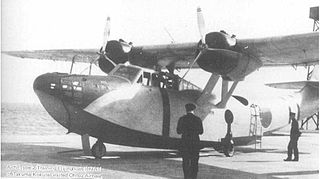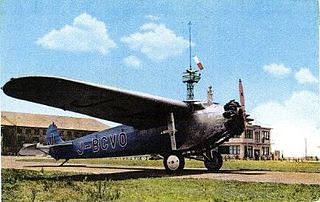
The Aichi D1A or Navy Type 94/96 Carrier Bomber was a Japanese carrier-based dive bomber of the 1930s. A single-engine, two-seat biplane based on the Heinkel He 50, the D1A was produced by Aichi for the Imperial Japanese Navy, remaining in service as a trainer at the time of the attack on Pearl Harbor. The D1A was produced in two variants, the D1A1, and the D1A2.

The Mitsubishi Ki-57 was a Japanese passenger transport aircraft, developed from the Ki-21 bomber, during the early 1940s.

The Aichi H9A was an Imperial Japanese Navy Air Service flying boat used during the first years of World War II for crew training. An uncommon type, it was not encountered by Allied forces until spring 1945, and was never assigned an Allied reporting name.

The Kawasaki Ki-32 was a Japanese light bomber aircraft of World War II. It was a single-engine, two-seat, mid-wing, cantilever monoplane with a fixed tailwheel undercarriage. An internal bomb bay accommodated a 300 kg (660 lb) offensive load, supplemented by 150 kg (330 lb) of bombs on external racks. During the war, it was known by the Allies by the name Mary.

The Mitsubishi Ki-21, formal designation "Type 97 Heavy Bomber" was a Japanese heavy bomber during World War II. It began operations during the Second Sino-Japanese War participating in the Nomonhan Incident, and in the first stages of the Pacific War, including the Malayan, Burmese, Dutch East Indies and New Guinea Campaigns. It was also used to attack targets as far-flung as western China, India and northern Australia. The Allies designated it under the reporting names "Sally" /"Gwen".

The Tachikawa Ki-9 was an intermediate training aircraft of the Imperial Japanese Army Air Force built by Tachikawa Aircraft Company Ltd in the 1930s. It was known to the Allies under the nickname of "Spruce" during World War II.

The Tachikawa Ki-94 was a single-seat fighter-Interceptor aircraft project undertaken by the Tachikawa Aircraft Company and to be operated by the Imperial Japanese Army. The project refers to two aircraft designs: the Ki-94-I and the Ki-94-II, both of which did not advance beyond the mock-up and prototype stage respectively.

The Tachikawa Ki-54 was a Japanese twin-engine advanced trainer used during World War II. The aircraft was named Hickory by the Allies.

The Yokosuka B4Y was a carrier-borne torpedo bomber used by the Imperial Japanese Navy Air Service from 1936 to 1943. The B4Y replaced the Mitsubishi B2M2 and the Yokosuka B3Y, and was the last biplane bomber used operationally by the Imperial Japanese Navy. The Allied reporting name was "Jean".

The Nakajima G5N Shinzan was a four-engined long-range heavy bomber designed and built for the Imperial Japanese Navy prior to World War II. The Navy designation was "Experimental 13-Shi Attack Bomber"; the Allied code name was "Liz".

The Nakajima Ki-49Donryu was a twin-engine Japanese World War II heavy bomber. It was designed to carry out daylight bombing missions, without the protection of escort fighters. Consequently, while its official designation, Army Type 100 Heavy Bomber, was accurate in regard to its formidable defensive armament and armor, these features restricted the Ki-49 to payloads comparable to those of lighter medium bombers – the initial production variant could carry only 1,000 kg (2,200 lb) of bombs.

The Nakajima Army Type 91 Fighter was a Japanese fighter of the 1930s. It was a single-engine, single-seat parasol monoplane with a fixed, tailskid undercarriage.

The Mitsubishi Ki-15Army Type 97 Command Reconnaissance aircraft was a Japanese reconnaissance aircraft and a light attack bomber of the Second Sino-Japanese War and Pacific War. It began as a fast civilian mail-plane. It was a single-engine, low-wing, cantilever monoplane with a fixed tailwheel undercarriage; it carried a crew of two. It served with both the Imperial Japanese Army and Navy. During World War II it was code-named "Babs" by the Allies.

The Nakajima Ki-4Kyūyon-shiki teisatsuki (九四式偵察機) was the last biplane reconnaissance aircraft of the Japanese Imperial Army. It saw combat service in Manchukuo and in north China during the early stages of the Second Sino-Japanese War.

The Kokusai Ki-59 was an early 1940s light transport monoplane built by Nippon Kokusai Koku Kogyo K.K for the Imperial Japanese Army as a development of the Teradako-ken TK-3 which had first flown in 1938.

The Mitsubishi Ki-2 was a light bomber built by Mitsubishi for the Imperial Japanese Army Air Service (IJAAS) in the 1930s. Its Allied nickname was "Louise". Despite its antiquated appearance, the Ki-2 was successfully used in Manchukuo and in North China during the early stages of the Second Sino-Japanese War, in areas where danger from enemy fighter aircraft was minimal. It was later used in a training role.

The Nakajima Ki-6 was a licensed-produced version of the Fokker Super Universal transport built by Nakajima Aircraft Company in the 1930s. Initially used as an airliner, the militarized version was used by the Imperial Japanese Army in a variety of roles, ranging from medical evacuation to transport and training aircraft. It was used extensively in combat zones in Manchukuo and in China during the Second Sino-Japanese War.

The Mitsubishi K3M was a trainer built by Mitsubishi which was used by the Imperial Japanese Navy in an extremely wide variety of roles, including light transport, liaison aircraft, utility aircraft and occasionally light bomber. Its Allied reporting name was Pine.

The Nakajima Ki-11 was an unsuccessful attempt by Nakajima Aircraft Company to meet a 1935 requirement issued by the Japanese government for a modern single-seat monoplane fighter suitable to meet the needs of both the Imperial Japanese Army Air Force and Imperial Japanese Navy Air Service

The Mitsubishi Ki-18 was an unsuccessful and unsolicited attempt by Mitsubishi to meet a 1934 requirement issued by the Japanese Army for a modern single-seat monoplane fighter suitable to the needs of the Imperial Japanese Army Air Force. During this competition, Nakajima entered the Nakajima Ki-11, and Kawasaki entered the more maneuverable Kawasaki Ki-10 biplane. The competition was won by Kawasaki, but the new fighter was not accepted by the IJAAF with much enthusiasm.

![Airborne Scene from "Kato hayabusa sento-tai [Colonel Kato's Falcon Squadron] Airborne Scene - Kato hayabusa sento-tai 1944 (04) wmplayer 2013-07-17.jpg](http://upload.wikimedia.org/wikipedia/commons/thumb/0/0f/Airborne_Scene_-_Kato_hayabusa_sento-tai_1944_%2804%29_wmplayer_2013-07-17.jpg/220px-Airborne_Scene_-_Kato_hayabusa_sento-tai_1944_%2804%29_wmplayer_2013-07-17.jpg)



















